Muscle Insider
New member
Skinny, beanpole, rawboned, scrawny, bony, lanky, skeletal, twiggy, gaunt, fragile, delicate, hollow-cheeked, as thin as a rake, skin-and-bones, sticklike, size-zero, emaciated, pinched, undernourished, underfed, rangy, spindly, gangly, gangling, gawky, spindle-shanked, starveling, and macilent. It would be safe to say that the world tends to be unkind when labeling underweight individuals.
Do you want to know the synonyms for ‘jacked’? Shredded, rugged, sturdy, muscly, stout, well-built, hefty, powerful, and lusty. If given a choice, most people would want to be a part of the latter group.
Ask a bro at your gym about putting on size, and they’ll tell you it is the easiest thing in the world. However, this is not always the case. Bulking up is simple in theory but difficult in execution. Although most of us know that we need to eat more to build muscle mass and size, it is only a piece of the puzzle.
You must stay in a calorie surplus to build muscle, meaning you must eat more calories daily than you expend. At the same time, these calories must come from nutrient-dense sources. Eating junk food and chugging sugar-laden aerated drinks can get you to your daily caloric goal, but in the long run, it will lead you toward obesity and other health issues.
A basic understanding of nutrition and how it plays a role in achieving your fitness goals is vital to be successful in your fitness journey. It will help you avoid fad diets and ensure you get the best bang for your buck.
In this article, we discuss the basics of bulking for skinny guys, including the nutrition breakdown, and lay down 15 nutrient-dense high-calorie foods to help you hit your daily caloric goals.
What is Bulking Up?
Contrary to what most people believe, bulking and weight gain are not the same thing. In a weight gain program, your only objective is to get from your current weight to your goal weight. However, in a bulking program, you must also gain muscle mass and improve your physique aesthetics.
Bulking up requires a combination of increased caloric intake and weight training exercises. During a bulking-up program, you want to add muscle mass to the body while minimizing fat gain.
Bulking is the name of the game for skinny guys wanting to add muscle mass. It requires consuming a high-calorie and protein diet and engaging in strength training exercises to stimulate muscle growth.
Besides helping you develop muscle size and strength, bulking up has several other benefits, including boosting metabolism and immune system, better nutrient absorption and energy levels, and improving overall health. Unlike the ‘dirty bulking’ diet, the nutrient-dense foods listed in this article will also avoid health issues, such as high cholesterol and high blood pressure. [1][2]
Although most people know they need to enter a calorie surplus to add size and strength, they are clueless about the foods they should add to their diet plan. If you are one of these people and are looking for answers, you’ve come to the right place. This article contains 15 high-calorie foods to help skinny guys build size and strength.
Overview of the 15 Best Foods For Bulking Up
We have put the nutritional information of the 15 foods into a convenient table with their serving sizes, calories, protein, carb, and fat content, to help you make the right dietary choices:
Food
Serving Size
Calories
Protein (in grams)
Carbohydrates (in grams)
Fats (in grams)
Whole Milk
1 cup
150
8
12
8
Cheese
1 oz
110
7
1
9
Nuts
1 oz
170-200
4-6
3-5
14-18
Avocado
1 medium
300
3
17
25
Peanut Butter
2 tbsp
200
8
6
16
Brown Rice
1 cup
220
5
45
2
Sweet Potato
1 medium
100
2
24
0.2
Whole-Grain Bread
2 slices
200-250
8-12
36-48
2-5
Dried Fruit
1 oz
100-120
0-1
25-30
0-1
Salmon
3 oz
150
17
0
9
Chicken Breast
100 gram
165
31
0
3.6
Beef
3 oz
180
22
0
10
Granola
1 cup
400-500
7-9
66-80
12-16
Quinoa
1 cup
220
8
39
3.5
Weight Gainer Shakes
1 serving
1,000-1,300
45-60
200-300
2-6
15 High-Calorie Foods For Skinny Guys To Bulk Up
Given below is a list of lean protein, fruit, nuts, and vegetables that will help underweight lifters bulk up:
Whole Milk
Whole milk is an excellent source of calories, protein, carbs, and fats. It is versatile and convenient; you could include milk in any of our meals throughout the day. It is also easily digestible.
Furthermore, skinny guys trying to bulk up can also include yogurt and curd in their grocery list. You can pair them with your three big meals or eat them as a snack anytime throughout the day.
A cup of whole milk contains 150 calories, eight grams of protein, 12 grams of carbohydrates, and eight grams of fat.
Cheese
Cheese is another dairy product that should be a part of a skinny individual’s dietary routine. This nutrient-dense food comes in different shapes and sizes, making it perfect to add to a wide variety of dishes.
Mozzarella, ricotta, cheddar, Swiss, feta, goat cheese, and cottage cheese are a few different types of cheese whose protein, carbs, fat, and calorie content can change depending on their making process.
One ounce of cheese delivers 110 calories, seven grams of protein, one gram of carbs, and nine grams of fats.
Nuts
Nuts are packed with fats and are a convenient source of the macronutrient. Besides fats, nuts contain a healthy amount of protein and carbs. You can also add seeds to your daily serving of nuts to make things more interesting.
Almonds, cashews, walnuts, hazelnuts, pistachios, Macadamia nuts, pumpkin seeds, and sunflower seeds are some of the most popular nuts and seeds. You can add nuts and seeds to your meals or grab them as a snack.
Depending on the type of nuts, one ounce serving of nuts contains 170-200 calories, 4-6 grams of protein, 3-5 grams of carbs, and 14-18 grams of fats.
Avocado
Avocado is popular among fitness enthusiasts as a high-quality fat source. This fruit primarily contains monounsaturated fats, fiber, and vitamins, which can help reduce the risk of blood pressure, regulate glucose levels, promote healthy blood lipid profiles, and improves insulin sensitivity.
Avocado is mostly added to salads or consumed by itself. You could also add avocados to smoothies for a quick high-calorie meal. Also, a guacamole dip is an excellent option for folks looking for a healthy spread.
One medium-sized avocado contains 300 calories, three grams of protein, 17 grams of carbs, and 25 grams of fats.
Peanut Butter
Peanut butter is a staple in most fitness enthusiasts’ cupboards. Although peanut butter is mainly eaten for its fat content, it also contains a healthy dose of protein and carbs. You could also add peanut butter to shakes and smoothies for a delicious snack.
Some alternatives to peanut butter include almond butter, cashew butter, and hazelnut butter. You could switch between these alternatives to keep your meals interesting. However, ensure that these butter are not laden with artificial sweeteners and sugar. Prefer organic peanut butter over the others.
Two tablespoons of peanut butter contain 200 calories, eight grams of protein, six grams of carbs, and 16 grams of fats.
Brown Rice
Brown rice is a complex carbohydrate that is an excellent energy source for the body. Carbs are the most crucial macronutrient during the bulking phase. Brown rice’s versatility makes them an excellent food to add to any meal and fill a calorie void.
A cup of brown rice includes 220 calories, five grams of protein, 45 grams of carbs, and two grams of fat.
Sweet Potato
This food is packed with complex carbohydrates, vitamins, and minerals. It is one of the few inherently delicious foods in a healthy diet. You could consume sweet potato as a side in your main meals or as a snack.
A medium sweet potato packs 100 calories, two grams of protein, 24 grams of carbs, and 0.2 grams of fats.
Whole-Grain Bread
Whole-grain breads are delectable and highly versatile. They contain a high-calorie content in a small serving size. Most people eat bread in their breakfast. However, you could add it to any of your meals.
Unlike refined white bread, whole grain bread contains the entire grain, providing a wealth of vitamins and minerals. Whole-grain bread also digests slower than white bread, providing a constant energy supply throughout the day.
Two slices of whole-grain bread contain 200-250 calories, 8-12 grams of protein, 36-48 grams of carbs, and 2-5 grams of fats, depending on the brand.
Dried Fruit
Dried fruit is a nutrient-dense snack that is easy to transport, has more shelf life than fresh fruit, and is easy to carry. It contains a good amount of carbs, fiber, vitamins, and minerals.
Almonds, cashews, raisins, apricots, dates, and prunes are a few types of dried fruit. Dried fruit is also great for satisfying your sweet cravings. However, dried fruit contains more concentrated sugar than fresh fruit. You must consume dried fruit in moderation, as excessive intake can lead to high sugar intake and digestive issues.
An ounce of dried fruit contains 100-120 calories, 0-1 grams of protein, 25-30 grams of carbs, and 0-1 grams of fats.
Salmon
Salmon is the go-to seafood for most lifters. This high-quality protein is rich in omega-3 fatty acids and is an excellent food choice for folks looking to build muscle and improve overall health. Since salmon is a quick-absorbing source of protein, consume it right after your workout for the best results.
Three ounces of salmon contains 150 calories, 17 grams of protein, zero carbohydrates, and nine grams of fat.
Chicken Breast
The good old chicken breast is one of the best foods for building muscle mass without adding body fat. You could consume chicken breast during your lunch or dinner and ideally after your training session.
A 100 grams serving of chicken breast consists of 165 calories, 31 grams of protein, zero carbs, and 3.6 grams of fat.
Beef
Beef is rich in protein and essential amino acids, which can help build muscle mass. It is also a good source of iron, zinc, and vitamin B12, improving overall health and vitality. Choose lean cuts of beef, such as sirloin, flank, or round steak, to limit your fat intake.
A three-ounce serving of beef contains 180 calories, 22 grams of protein, no carbs, and 10 grams of fat.
Granola
Granola is an often overlooked complex carbohydrate in a bulking regimen. It is an excellent breakfast food and snack that is made from a combination of oats, nuts, seeds, and dried fruits. Granola also contains a healthy dose of fat and protein, making it a well-rounded food source.
A cup of granola generally comprises 400-500 calories, 7-9 grams of protein, 66-80 grams of carbs, and 12-16 grams of fat.
Quinoa
Quinoa is one of the few plant-based foods with a complete protein source, meaning it contains all of the essential amino acids the body needs to build muscle. It is a must-have in every vegan diet. You can add quinoa to salads, stir-fries, or as a side dish.
A cup of quinoa delivers 220 calories, eight grams of protein, 39 grams of carbs, and 3.5 grams of fats.
Weight Gainer Shakes
Weight gainer shakes are a godsend for folks who have difficulty meeting their nutrition goals through whole foods. A serving of a weight gainer can contain between 200-300 grams of carbs and a decent amount of protein. You could also use a whey protein supplement instead of a mass gainer, as per your macros.
Depending on the brand, a 300-400 gram serving of a mass gainer supplement delivers a monster 1,000-1,300 calories, 45-60 grams of protein, 200-300 grams of carbs, and 2-6 grams of fat.
Tip: Calculate your recommend daily protein, carbs and fat intake.
Nutrition Planning For Bulking Up For Skinny Guys
Now that you know about the 15 high-calorie foods to help skinny guys bulk up and build muscle, it is time to put the knowledge to work. Here are some nutrition planning tips to help you in the process:
Calories
Skinny folks must use a calculated approach to enter a calorie surplus to add size and strength. Your goal should be to eat 300-500 additional calories daily. Bumping up your calories by 500 kcal will help you gain a pound of weight each week, which is a sustainable and healthy approach to bulking up. [3]
Macronutrient
After arriving at a daily calorie goal, you must break it down into a suitable carbs, protein, and fats ratio to achieve your goal physique. A 40-30-30 split (40% carbs, 30% protein, and 30% fats) is one of the most reliable macronutrient ratios for building muscle mass and strength while limiting fat buildup.
Here is an oversimplified step-by-step process for setting a calorie and macronutrient goal to bulk up for skinny guys:
Use a calorie-tracking tracking app, such as MyFitnessPal, to calculate your daily average calorie intake for the last five days.
Bump up your calorie intake by 300-500 calories.
Break down the calorie goal into a suitable macronutrient split.
Alternatively, you could use our online calorie and macronutrient calculators for this process.
Design a diet using the 15 high-calorie, nutrient-dense foods mentioned in this article.
Remember, you might need to tweak your diet plan for the first few weeks until you find something that works for you. Seek expert help if you have trouble designing a diet plan; it will save you a lot of time, effort, and money.
Wrapping Up
Skinny folks must enter a caloric surplus to build muscle and strength. However, you must remember that all calories are not created equal. Although dirty bulking is more convenient (and delicious), it can lead to excess body fat and chronic health conditions.
Skinny guys must add the 15 high-calorie, nutrient-dense foods mentioned in this article to their grocery list and follow a customized training program to bulk up sustainably, improve their overall health and physical performance, and achieve the physiques of their dreams.
References
Troesch B, Biesalski HK, Bos R, Buskens E, Calder PC, Saris WH, Spieldenner J, Verkade HJ, Weber P, Eggersdorfer M. Increased Intake of Foods with High Nutrient Density Can Help to Break the Intergenerational Cycle of Malnutrition and Obesity. Nutrients. 2015 Jul 21;7(7):6016-37. doi: 10.3390/nu7075266. PMID: 26197337; PMCID: PMC4517043.
Drewnowski A. Impact of nutrition interventions and dietary nutrient density on productivity in the workplace. Nutr Rev. 2020 Mar 1;78(3):215-224. doi: 10.1093/nutrit/nuz088. PMID: 31889196.
Cleveland Clinic. “High-Calorie Foods and Snack Ideas to Gain Weight.” Cleveland Clinic, 2020, https://my.clevelandclinic.org/health/articles/16555-snack-ideas-for-weight-gain. Accessed May 8, 2023?
Related:
Skinny, beanpole, rawboned, scrawny, bony, lanky, skeletal, twiggy, gaunt, fragile, delicate, hollow-cheeked, as thin as a rake, skin-and-bones, sticklike, size-zero, emaciated, pinched, undernourished, underfed, rangy, spindly, gangly, gangling, gawky, spindle-shanked, starveling, and macilent. It would be safe to say that the world tends to be unkind when labeling underweight individuals.
Do you want to know the synonyms for ‘jacked’? Shredded, rugged, sturdy, muscly, stout, well-built, hefty, powerful, and lusty. If given a choice, most people would want to be a part of the latter group.
Ask a bro at your gym about putting on size, and they’ll tell you it is the easiest thing in the world. However, this is not always the case. Bulking up is simple in theory but difficult in execution. Although most of us know that we need to eat more to build muscle mass and size, it is only a piece of the puzzle.
You must stay in a calorie surplus to build muscle, meaning you must eat more calories daily than you expend. At the same time, these calories must come from nutrient-dense sources. Eating junk food and chugging sugar-laden aerated drinks can get you to your daily caloric goal, but in the long run, it will lead you toward obesity and other health issues.
A basic understanding of nutrition and how it plays a role in achieving your fitness goals is vital to be successful in your fitness journey. It will help you avoid fad diets and ensure you get the best bang for your buck.
In this article, we discuss the basics of bulking for skinny guys, including the nutrition breakdown, and lay down 15 nutrient-dense high-calorie foods to help you hit your daily caloric goals.
What is Bulking Up?
Contrary to what most people believe, bulking and weight gain are not the same thing. In a weight gain program, your only objective is to get from your current weight to your goal weight. However, in a bulking program, you must also gain muscle mass and improve your physique aesthetics.
Bulking up requires a combination of increased caloric intake and weight training exercises. During a bulking-up program, you want to add muscle mass to the body while minimizing fat gain.
Bulking is the name of the game for skinny guys wanting to add muscle mass. It requires consuming a high-calorie and protein diet and engaging in strength training exercises to stimulate muscle growth.
Besides helping you develop muscle size and strength, bulking up has several other benefits, including boosting metabolism and immune system, better nutrient absorption and energy levels, and improving overall health. Unlike the ‘dirty bulking’ diet, the nutrient-dense foods listed in this article will also avoid health issues, such as high cholesterol and high blood pressure. [1][2]
Although most people know they need to enter a calorie surplus to add size and strength, they are clueless about the foods they should add to their diet plan. If you are one of these people and are looking for answers, you’ve come to the right place. This article contains 15 high-calorie foods to help skinny guys build size and strength.
Overview of the 15 Best Foods For Bulking Up
We have put the nutritional information of the 15 foods into a convenient table with their serving sizes, calories, protein, carb, and fat content, to help you make the right dietary choices:
Food
Serving Size
Calories
Protein (in grams)
Carbohydrates (in grams)
Fats (in grams)
Whole Milk
1 cup
150
8
12
8
Cheese
1 oz
110
7
1
9
Nuts
1 oz
170-200
4-6
3-5
14-18
Avocado
1 medium
300
3
17
25
Peanut Butter
2 tbsp
200
8
6
16
Brown Rice
1 cup
220
5
45
2
Sweet Potato
1 medium
100
2
24
0.2
Whole-Grain Bread
2 slices
200-250
8-12
36-48
2-5
Dried Fruit
1 oz
100-120
0-1
25-30
0-1
Salmon
3 oz
150
17
0
9
Chicken Breast
100 gram
165
31
0
3.6
Beef
3 oz
180
22
0
10
Granola
1 cup
400-500
7-9
66-80
12-16
Quinoa
1 cup
220
8
39
3.5
Weight Gainer Shakes
1 serving
1,000-1,300
45-60
200-300
2-6
15 High-Calorie Foods For Skinny Guys To Bulk Up
Given below is a list of lean protein, fruit, nuts, and vegetables that will help underweight lifters bulk up:
Whole Milk
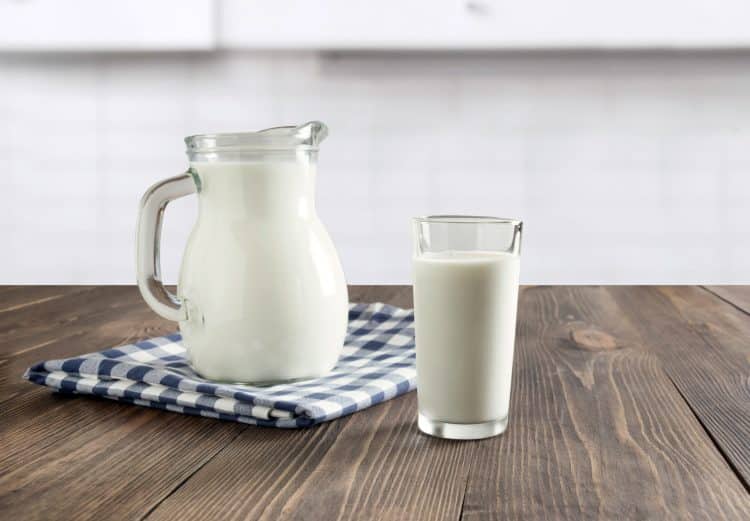

Whole milk is an excellent source of calories, protein, carbs, and fats. It is versatile and convenient; you could include milk in any of our meals throughout the day. It is also easily digestible.
Furthermore, skinny guys trying to bulk up can also include yogurt and curd in their grocery list. You can pair them with your three big meals or eat them as a snack anytime throughout the day.
A cup of whole milk contains 150 calories, eight grams of protein, 12 grams of carbohydrates, and eight grams of fat.
Cheese
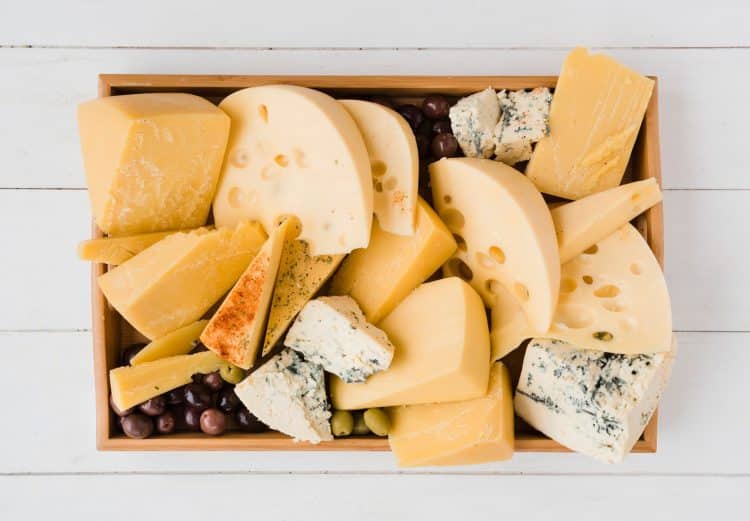

Cheese is another dairy product that should be a part of a skinny individual’s dietary routine. This nutrient-dense food comes in different shapes and sizes, making it perfect to add to a wide variety of dishes.
Mozzarella, ricotta, cheddar, Swiss, feta, goat cheese, and cottage cheese are a few different types of cheese whose protein, carbs, fat, and calorie content can change depending on their making process.
One ounce of cheese delivers 110 calories, seven grams of protein, one gram of carbs, and nine grams of fats.
Nuts


Nuts are packed with fats and are a convenient source of the macronutrient. Besides fats, nuts contain a healthy amount of protein and carbs. You can also add seeds to your daily serving of nuts to make things more interesting.
Almonds, cashews, walnuts, hazelnuts, pistachios, Macadamia nuts, pumpkin seeds, and sunflower seeds are some of the most popular nuts and seeds. You can add nuts and seeds to your meals or grab them as a snack.
Depending on the type of nuts, one ounce serving of nuts contains 170-200 calories, 4-6 grams of protein, 3-5 grams of carbs, and 14-18 grams of fats.
Avocado
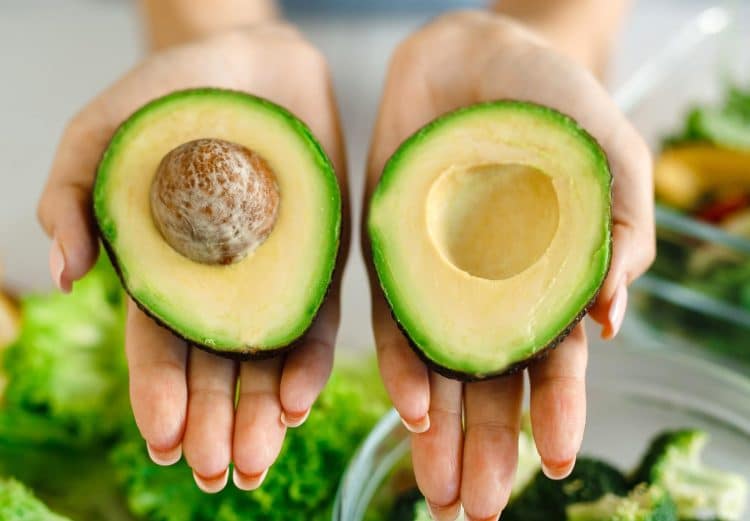

Avocado is popular among fitness enthusiasts as a high-quality fat source. This fruit primarily contains monounsaturated fats, fiber, and vitamins, which can help reduce the risk of blood pressure, regulate glucose levels, promote healthy blood lipid profiles, and improves insulin sensitivity.
Avocado is mostly added to salads or consumed by itself. You could also add avocados to smoothies for a quick high-calorie meal. Also, a guacamole dip is an excellent option for folks looking for a healthy spread.
One medium-sized avocado contains 300 calories, three grams of protein, 17 grams of carbs, and 25 grams of fats.
Peanut Butter
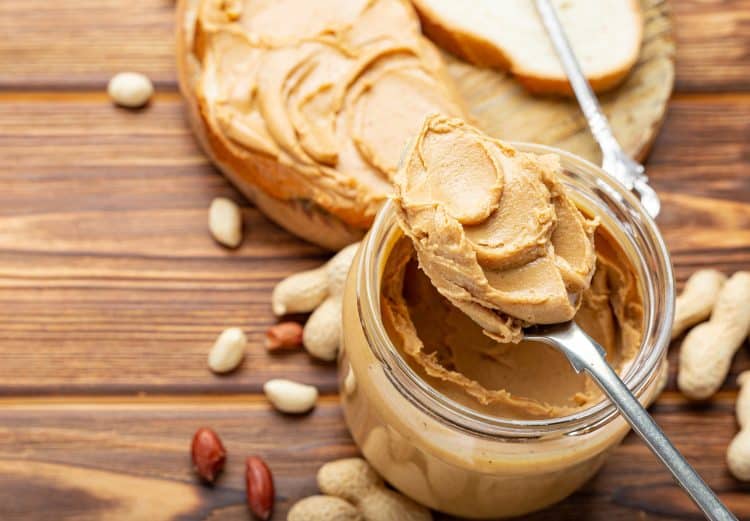

Peanut butter is a staple in most fitness enthusiasts’ cupboards. Although peanut butter is mainly eaten for its fat content, it also contains a healthy dose of protein and carbs. You could also add peanut butter to shakes and smoothies for a delicious snack.
Some alternatives to peanut butter include almond butter, cashew butter, and hazelnut butter. You could switch between these alternatives to keep your meals interesting. However, ensure that these butter are not laden with artificial sweeteners and sugar. Prefer organic peanut butter over the others.
Two tablespoons of peanut butter contain 200 calories, eight grams of protein, six grams of carbs, and 16 grams of fats.
Brown Rice


Brown rice is a complex carbohydrate that is an excellent energy source for the body. Carbs are the most crucial macronutrient during the bulking phase. Brown rice’s versatility makes them an excellent food to add to any meal and fill a calorie void.
A cup of brown rice includes 220 calories, five grams of protein, 45 grams of carbs, and two grams of fat.
Sweet Potato


This food is packed with complex carbohydrates, vitamins, and minerals. It is one of the few inherently delicious foods in a healthy diet. You could consume sweet potato as a side in your main meals or as a snack.
A medium sweet potato packs 100 calories, two grams of protein, 24 grams of carbs, and 0.2 grams of fats.
Whole-Grain Bread
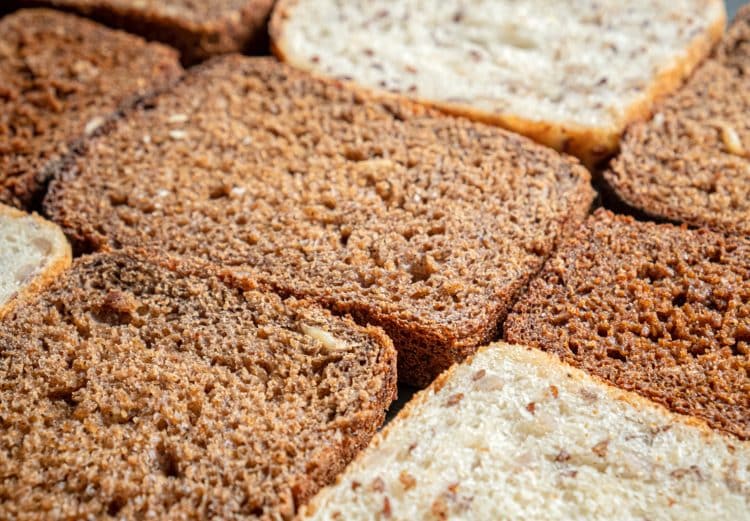

Whole-grain breads are delectable and highly versatile. They contain a high-calorie content in a small serving size. Most people eat bread in their breakfast. However, you could add it to any of your meals.
Unlike refined white bread, whole grain bread contains the entire grain, providing a wealth of vitamins and minerals. Whole-grain bread also digests slower than white bread, providing a constant energy supply throughout the day.
Two slices of whole-grain bread contain 200-250 calories, 8-12 grams of protein, 36-48 grams of carbs, and 2-5 grams of fats, depending on the brand.
Dried Fruit
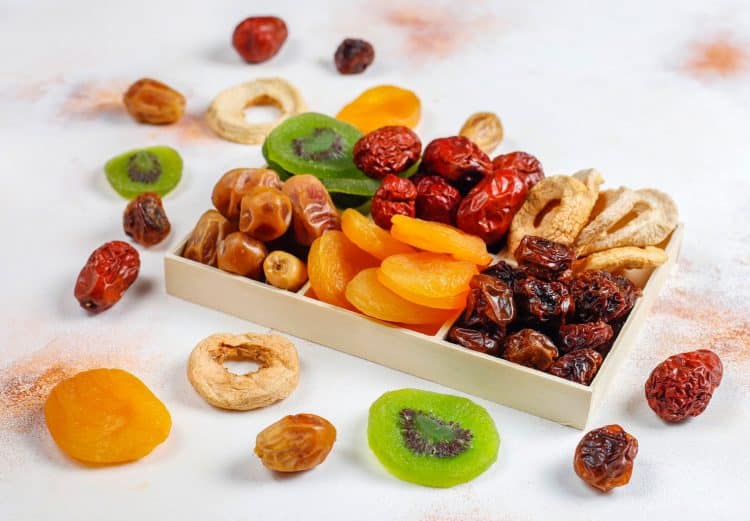

Dried fruit is a nutrient-dense snack that is easy to transport, has more shelf life than fresh fruit, and is easy to carry. It contains a good amount of carbs, fiber, vitamins, and minerals.
Almonds, cashews, raisins, apricots, dates, and prunes are a few types of dried fruit. Dried fruit is also great for satisfying your sweet cravings. However, dried fruit contains more concentrated sugar than fresh fruit. You must consume dried fruit in moderation, as excessive intake can lead to high sugar intake and digestive issues.
An ounce of dried fruit contains 100-120 calories, 0-1 grams of protein, 25-30 grams of carbs, and 0-1 grams of fats.
Salmon


Salmon is the go-to seafood for most lifters. This high-quality protein is rich in omega-3 fatty acids and is an excellent food choice for folks looking to build muscle and improve overall health. Since salmon is a quick-absorbing source of protein, consume it right after your workout for the best results.
Three ounces of salmon contains 150 calories, 17 grams of protein, zero carbohydrates, and nine grams of fat.
Chicken Breast
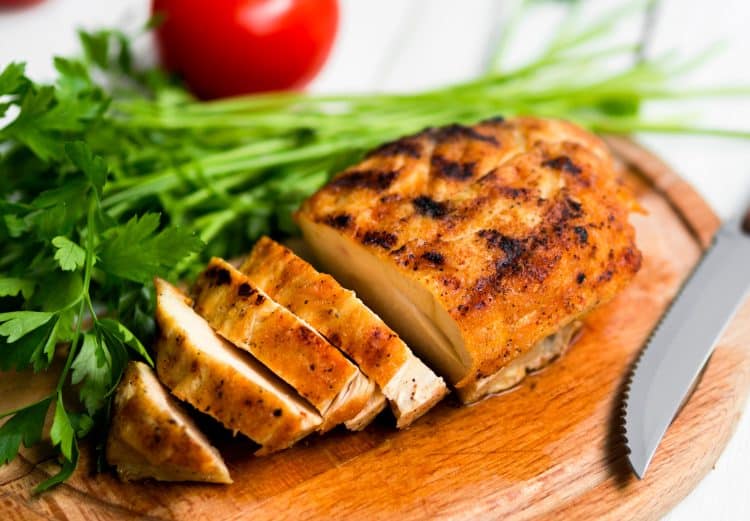

The good old chicken breast is one of the best foods for building muscle mass without adding body fat. You could consume chicken breast during your lunch or dinner and ideally after your training session.
A 100 grams serving of chicken breast consists of 165 calories, 31 grams of protein, zero carbs, and 3.6 grams of fat.
Beef


Beef is rich in protein and essential amino acids, which can help build muscle mass. It is also a good source of iron, zinc, and vitamin B12, improving overall health and vitality. Choose lean cuts of beef, such as sirloin, flank, or round steak, to limit your fat intake.
A three-ounce serving of beef contains 180 calories, 22 grams of protein, no carbs, and 10 grams of fat.
Granola
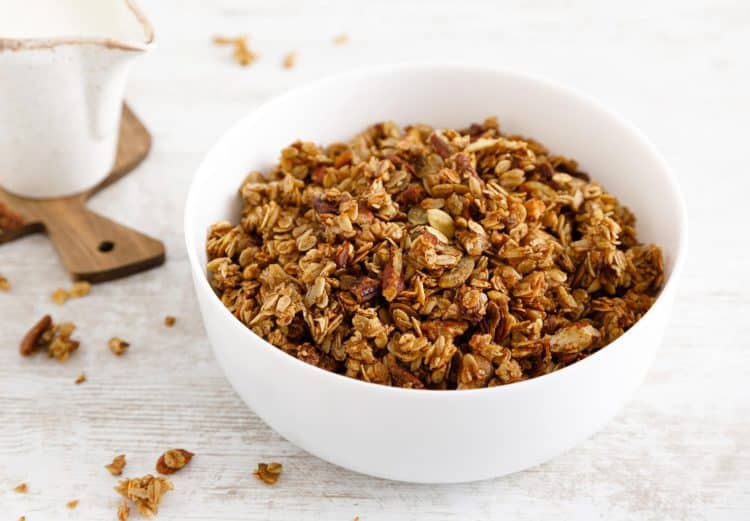

Granola is an often overlooked complex carbohydrate in a bulking regimen. It is an excellent breakfast food and snack that is made from a combination of oats, nuts, seeds, and dried fruits. Granola also contains a healthy dose of fat and protein, making it a well-rounded food source.
A cup of granola generally comprises 400-500 calories, 7-9 grams of protein, 66-80 grams of carbs, and 12-16 grams of fat.
Quinoa


Quinoa is one of the few plant-based foods with a complete protein source, meaning it contains all of the essential amino acids the body needs to build muscle. It is a must-have in every vegan diet. You can add quinoa to salads, stir-fries, or as a side dish.
A cup of quinoa delivers 220 calories, eight grams of protein, 39 grams of carbs, and 3.5 grams of fats.
Weight Gainer Shakes
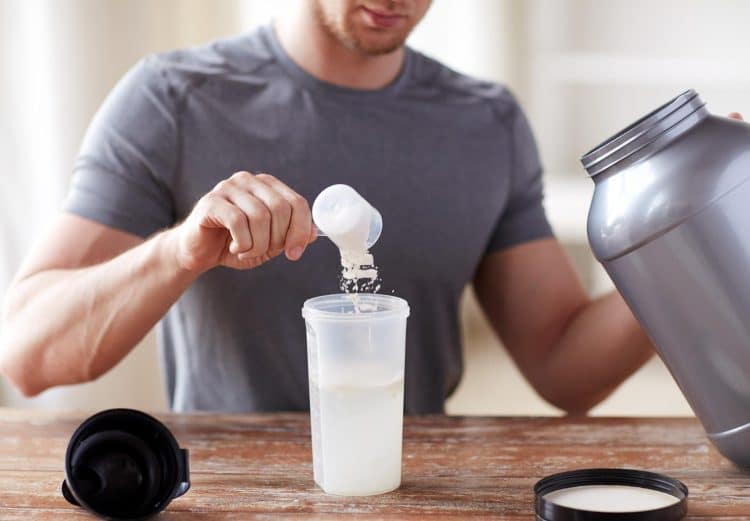

Weight gainer shakes are a godsend for folks who have difficulty meeting their nutrition goals through whole foods. A serving of a weight gainer can contain between 200-300 grams of carbs and a decent amount of protein. You could also use a whey protein supplement instead of a mass gainer, as per your macros.
Depending on the brand, a 300-400 gram serving of a mass gainer supplement delivers a monster 1,000-1,300 calories, 45-60 grams of protein, 200-300 grams of carbs, and 2-6 grams of fat.
Tip: Calculate your recommend daily protein, carbs and fat intake.
Nutrition Planning For Bulking Up For Skinny Guys
Now that you know about the 15 high-calorie foods to help skinny guys bulk up and build muscle, it is time to put the knowledge to work. Here are some nutrition planning tips to help you in the process:
Calories
Skinny folks must use a calculated approach to enter a calorie surplus to add size and strength. Your goal should be to eat 300-500 additional calories daily. Bumping up your calories by 500 kcal will help you gain a pound of weight each week, which is a sustainable and healthy approach to bulking up. [3]
Macronutrient
After arriving at a daily calorie goal, you must break it down into a suitable carbs, protein, and fats ratio to achieve your goal physique. A 40-30-30 split (40% carbs, 30% protein, and 30% fats) is one of the most reliable macronutrient ratios for building muscle mass and strength while limiting fat buildup.
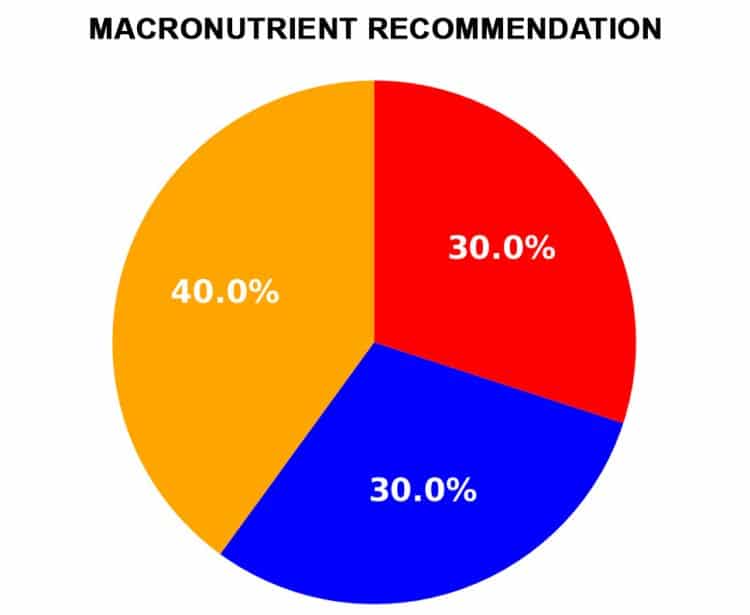

Here is an oversimplified step-by-step process for setting a calorie and macronutrient goal to bulk up for skinny guys:
[*]Use a calorie-tracking tracking app, such as MyFitnessPal, to calculate your daily average calorie intake for the last five days.
[*]Bump up your calorie intake by 300-500 calories.
[*]Break down the calorie goal into a suitable macronutrient split.
[*]Alternatively, you could use our online calorie and macronutrient calculators for this process.
[*]Design a diet using the 15 high-calorie, nutrient-dense foods mentioned in this article.
Remember, you might need to tweak your diet plan for the first few weeks until you find something that works for you. Seek expert help if you have trouble designing a diet plan; it will save you a lot of time, effort, and money.
Wrapping Up
Skinny folks must enter a caloric surplus to build muscle and strength. However, you must remember that all calories are not created equal. Although dirty bulking is more convenient (and delicious), it can lead to excess body fat and chronic health conditions.
Skinny guys must add the 15 high-calorie, nutrient-dense foods mentioned in this article to their grocery list and follow a customized training program to bulk up sustainably, improve their overall health and physical performance, and achieve the physiques of their dreams.
References
[*]Troesch B, Biesalski HK, Bos R, Buskens E, Calder PC, Saris WH, Spieldenner J, Verkade HJ, Weber P, Eggersdorfer M. Increased Intake of Foods with High Nutrient Density Can Help to Break the Intergenerational Cycle of Malnutrition and Obesity. Nutrients. 2015 Jul 21;7(7):6016-37. doi: 10.3390/nu7075266. PMID: 26197337; PMCID: PMC4517043.
[*]Drewnowski A. Impact of nutrition interventions and dietary nutrient density on productivity in the workplace. Nutr Rev. 2020 Mar 1;78(3):215-224. doi: 10.1093/nutrit/nuz088. PMID: 31889196.
[*]Cleveland Clinic. “High-Calorie Foods and Snack Ideas to Gain Weight.” Cleveland Clinic, 2020, https://my.clevelandclinic.org/health/articles/16555-snack-ideas-for-weight-gain. Accessed May 8, 2023?
Related:
Click here to view the article.
Do you want to know the synonyms for ‘jacked’? Shredded, rugged, sturdy, muscly, stout, well-built, hefty, powerful, and lusty. If given a choice, most people would want to be a part of the latter group.
Ask a bro at your gym about putting on size, and they’ll tell you it is the easiest thing in the world. However, this is not always the case. Bulking up is simple in theory but difficult in execution. Although most of us know that we need to eat more to build muscle mass and size, it is only a piece of the puzzle.
You must stay in a calorie surplus to build muscle, meaning you must eat more calories daily than you expend. At the same time, these calories must come from nutrient-dense sources. Eating junk food and chugging sugar-laden aerated drinks can get you to your daily caloric goal, but in the long run, it will lead you toward obesity and other health issues.
A basic understanding of nutrition and how it plays a role in achieving your fitness goals is vital to be successful in your fitness journey. It will help you avoid fad diets and ensure you get the best bang for your buck.
In this article, we discuss the basics of bulking for skinny guys, including the nutrition breakdown, and lay down 15 nutrient-dense high-calorie foods to help you hit your daily caloric goals.
What is Bulking Up?
Contrary to what most people believe, bulking and weight gain are not the same thing. In a weight gain program, your only objective is to get from your current weight to your goal weight. However, in a bulking program, you must also gain muscle mass and improve your physique aesthetics.
Bulking up requires a combination of increased caloric intake and weight training exercises. During a bulking-up program, you want to add muscle mass to the body while minimizing fat gain.
Bulking is the name of the game for skinny guys wanting to add muscle mass. It requires consuming a high-calorie and protein diet and engaging in strength training exercises to stimulate muscle growth.
Besides helping you develop muscle size and strength, bulking up has several other benefits, including boosting metabolism and immune system, better nutrient absorption and energy levels, and improving overall health. Unlike the ‘dirty bulking’ diet, the nutrient-dense foods listed in this article will also avoid health issues, such as high cholesterol and high blood pressure. [1][2]
Although most people know they need to enter a calorie surplus to add size and strength, they are clueless about the foods they should add to their diet plan. If you are one of these people and are looking for answers, you’ve come to the right place. This article contains 15 high-calorie foods to help skinny guys build size and strength.
Overview of the 15 Best Foods For Bulking Up
We have put the nutritional information of the 15 foods into a convenient table with their serving sizes, calories, protein, carb, and fat content, to help you make the right dietary choices:
Food
Serving Size
Calories
Protein (in grams)
Carbohydrates (in grams)
Fats (in grams)
Whole Milk
1 cup
150
8
12
8
Cheese
1 oz
110
7
1
9
Nuts
1 oz
170-200
4-6
3-5
14-18
Avocado
1 medium
300
3
17
25
Peanut Butter
2 tbsp
200
8
6
16
Brown Rice
1 cup
220
5
45
2
Sweet Potato
1 medium
100
2
24
0.2
Whole-Grain Bread
2 slices
200-250
8-12
36-48
2-5
Dried Fruit
1 oz
100-120
0-1
25-30
0-1
Salmon
3 oz
150
17
0
9
Chicken Breast
100 gram
165
31
0
3.6
Beef
3 oz
180
22
0
10
Granola
1 cup
400-500
7-9
66-80
12-16
Quinoa
1 cup
220
8
39
3.5
Weight Gainer Shakes
1 serving
1,000-1,300
45-60
200-300
2-6
15 High-Calorie Foods For Skinny Guys To Bulk Up
Given below is a list of lean protein, fruit, nuts, and vegetables that will help underweight lifters bulk up:
Whole Milk
Whole milk is an excellent source of calories, protein, carbs, and fats. It is versatile and convenient; you could include milk in any of our meals throughout the day. It is also easily digestible.
Furthermore, skinny guys trying to bulk up can also include yogurt and curd in their grocery list. You can pair them with your three big meals or eat them as a snack anytime throughout the day.
A cup of whole milk contains 150 calories, eight grams of protein, 12 grams of carbohydrates, and eight grams of fat.
Cheese
Cheese is another dairy product that should be a part of a skinny individual’s dietary routine. This nutrient-dense food comes in different shapes and sizes, making it perfect to add to a wide variety of dishes.
Mozzarella, ricotta, cheddar, Swiss, feta, goat cheese, and cottage cheese are a few different types of cheese whose protein, carbs, fat, and calorie content can change depending on their making process.
One ounce of cheese delivers 110 calories, seven grams of protein, one gram of carbs, and nine grams of fats.
Nuts
Nuts are packed with fats and are a convenient source of the macronutrient. Besides fats, nuts contain a healthy amount of protein and carbs. You can also add seeds to your daily serving of nuts to make things more interesting.
Almonds, cashews, walnuts, hazelnuts, pistachios, Macadamia nuts, pumpkin seeds, and sunflower seeds are some of the most popular nuts and seeds. You can add nuts and seeds to your meals or grab them as a snack.
Depending on the type of nuts, one ounce serving of nuts contains 170-200 calories, 4-6 grams of protein, 3-5 grams of carbs, and 14-18 grams of fats.
Avocado
Avocado is popular among fitness enthusiasts as a high-quality fat source. This fruit primarily contains monounsaturated fats, fiber, and vitamins, which can help reduce the risk of blood pressure, regulate glucose levels, promote healthy blood lipid profiles, and improves insulin sensitivity.
Avocado is mostly added to salads or consumed by itself. You could also add avocados to smoothies for a quick high-calorie meal. Also, a guacamole dip is an excellent option for folks looking for a healthy spread.
One medium-sized avocado contains 300 calories, three grams of protein, 17 grams of carbs, and 25 grams of fats.
Peanut Butter
Peanut butter is a staple in most fitness enthusiasts’ cupboards. Although peanut butter is mainly eaten for its fat content, it also contains a healthy dose of protein and carbs. You could also add peanut butter to shakes and smoothies for a delicious snack.
Some alternatives to peanut butter include almond butter, cashew butter, and hazelnut butter. You could switch between these alternatives to keep your meals interesting. However, ensure that these butter are not laden with artificial sweeteners and sugar. Prefer organic peanut butter over the others.
Two tablespoons of peanut butter contain 200 calories, eight grams of protein, six grams of carbs, and 16 grams of fats.
Brown Rice
Brown rice is a complex carbohydrate that is an excellent energy source for the body. Carbs are the most crucial macronutrient during the bulking phase. Brown rice’s versatility makes them an excellent food to add to any meal and fill a calorie void.
A cup of brown rice includes 220 calories, five grams of protein, 45 grams of carbs, and two grams of fat.
Sweet Potato
This food is packed with complex carbohydrates, vitamins, and minerals. It is one of the few inherently delicious foods in a healthy diet. You could consume sweet potato as a side in your main meals or as a snack.
A medium sweet potato packs 100 calories, two grams of protein, 24 grams of carbs, and 0.2 grams of fats.
Whole-Grain Bread
Whole-grain breads are delectable and highly versatile. They contain a high-calorie content in a small serving size. Most people eat bread in their breakfast. However, you could add it to any of your meals.
Unlike refined white bread, whole grain bread contains the entire grain, providing a wealth of vitamins and minerals. Whole-grain bread also digests slower than white bread, providing a constant energy supply throughout the day.
Two slices of whole-grain bread contain 200-250 calories, 8-12 grams of protein, 36-48 grams of carbs, and 2-5 grams of fats, depending on the brand.
Dried Fruit
Dried fruit is a nutrient-dense snack that is easy to transport, has more shelf life than fresh fruit, and is easy to carry. It contains a good amount of carbs, fiber, vitamins, and minerals.
Almonds, cashews, raisins, apricots, dates, and prunes are a few types of dried fruit. Dried fruit is also great for satisfying your sweet cravings. However, dried fruit contains more concentrated sugar than fresh fruit. You must consume dried fruit in moderation, as excessive intake can lead to high sugar intake and digestive issues.
An ounce of dried fruit contains 100-120 calories, 0-1 grams of protein, 25-30 grams of carbs, and 0-1 grams of fats.
Salmon
Salmon is the go-to seafood for most lifters. This high-quality protein is rich in omega-3 fatty acids and is an excellent food choice for folks looking to build muscle and improve overall health. Since salmon is a quick-absorbing source of protein, consume it right after your workout for the best results.
Three ounces of salmon contains 150 calories, 17 grams of protein, zero carbohydrates, and nine grams of fat.
Chicken Breast
The good old chicken breast is one of the best foods for building muscle mass without adding body fat. You could consume chicken breast during your lunch or dinner and ideally after your training session.
A 100 grams serving of chicken breast consists of 165 calories, 31 grams of protein, zero carbs, and 3.6 grams of fat.
Beef
Beef is rich in protein and essential amino acids, which can help build muscle mass. It is also a good source of iron, zinc, and vitamin B12, improving overall health and vitality. Choose lean cuts of beef, such as sirloin, flank, or round steak, to limit your fat intake.
A three-ounce serving of beef contains 180 calories, 22 grams of protein, no carbs, and 10 grams of fat.
Granola
Granola is an often overlooked complex carbohydrate in a bulking regimen. It is an excellent breakfast food and snack that is made from a combination of oats, nuts, seeds, and dried fruits. Granola also contains a healthy dose of fat and protein, making it a well-rounded food source.
A cup of granola generally comprises 400-500 calories, 7-9 grams of protein, 66-80 grams of carbs, and 12-16 grams of fat.
Quinoa
Quinoa is one of the few plant-based foods with a complete protein source, meaning it contains all of the essential amino acids the body needs to build muscle. It is a must-have in every vegan diet. You can add quinoa to salads, stir-fries, or as a side dish.
A cup of quinoa delivers 220 calories, eight grams of protein, 39 grams of carbs, and 3.5 grams of fats.
Weight Gainer Shakes
Weight gainer shakes are a godsend for folks who have difficulty meeting their nutrition goals through whole foods. A serving of a weight gainer can contain between 200-300 grams of carbs and a decent amount of protein. You could also use a whey protein supplement instead of a mass gainer, as per your macros.
Depending on the brand, a 300-400 gram serving of a mass gainer supplement delivers a monster 1,000-1,300 calories, 45-60 grams of protein, 200-300 grams of carbs, and 2-6 grams of fat.
Tip: Calculate your recommend daily protein, carbs and fat intake.
Nutrition Planning For Bulking Up For Skinny Guys
Now that you know about the 15 high-calorie foods to help skinny guys bulk up and build muscle, it is time to put the knowledge to work. Here are some nutrition planning tips to help you in the process:
Calories
Skinny folks must use a calculated approach to enter a calorie surplus to add size and strength. Your goal should be to eat 300-500 additional calories daily. Bumping up your calories by 500 kcal will help you gain a pound of weight each week, which is a sustainable and healthy approach to bulking up. [3]
Macronutrient
After arriving at a daily calorie goal, you must break it down into a suitable carbs, protein, and fats ratio to achieve your goal physique. A 40-30-30 split (40% carbs, 30% protein, and 30% fats) is one of the most reliable macronutrient ratios for building muscle mass and strength while limiting fat buildup.
Here is an oversimplified step-by-step process for setting a calorie and macronutrient goal to bulk up for skinny guys:
Use a calorie-tracking tracking app, such as MyFitnessPal, to calculate your daily average calorie intake for the last five days.
Bump up your calorie intake by 300-500 calories.
Break down the calorie goal into a suitable macronutrient split.
Alternatively, you could use our online calorie and macronutrient calculators for this process.
Design a diet using the 15 high-calorie, nutrient-dense foods mentioned in this article.
Remember, you might need to tweak your diet plan for the first few weeks until you find something that works for you. Seek expert help if you have trouble designing a diet plan; it will save you a lot of time, effort, and money.
Wrapping Up
Skinny folks must enter a caloric surplus to build muscle and strength. However, you must remember that all calories are not created equal. Although dirty bulking is more convenient (and delicious), it can lead to excess body fat and chronic health conditions.
Skinny guys must add the 15 high-calorie, nutrient-dense foods mentioned in this article to their grocery list and follow a customized training program to bulk up sustainably, improve their overall health and physical performance, and achieve the physiques of their dreams.
References
Troesch B, Biesalski HK, Bos R, Buskens E, Calder PC, Saris WH, Spieldenner J, Verkade HJ, Weber P, Eggersdorfer M. Increased Intake of Foods with High Nutrient Density Can Help to Break the Intergenerational Cycle of Malnutrition and Obesity. Nutrients. 2015 Jul 21;7(7):6016-37. doi: 10.3390/nu7075266. PMID: 26197337; PMCID: PMC4517043.
Drewnowski A. Impact of nutrition interventions and dietary nutrient density on productivity in the workplace. Nutr Rev. 2020 Mar 1;78(3):215-224. doi: 10.1093/nutrit/nuz088. PMID: 31889196.
Cleveland Clinic. “High-Calorie Foods and Snack Ideas to Gain Weight.” Cleveland Clinic, 2020, https://my.clevelandclinic.org/health/articles/16555-snack-ideas-for-weight-gain. Accessed May 8, 2023?
Related:
Skinny, beanpole, rawboned, scrawny, bony, lanky, skeletal, twiggy, gaunt, fragile, delicate, hollow-cheeked, as thin as a rake, skin-and-bones, sticklike, size-zero, emaciated, pinched, undernourished, underfed, rangy, spindly, gangly, gangling, gawky, spindle-shanked, starveling, and macilent. It would be safe to say that the world tends to be unkind when labeling underweight individuals.
Do you want to know the synonyms for ‘jacked’? Shredded, rugged, sturdy, muscly, stout, well-built, hefty, powerful, and lusty. If given a choice, most people would want to be a part of the latter group.
Ask a bro at your gym about putting on size, and they’ll tell you it is the easiest thing in the world. However, this is not always the case. Bulking up is simple in theory but difficult in execution. Although most of us know that we need to eat more to build muscle mass and size, it is only a piece of the puzzle.
You must stay in a calorie surplus to build muscle, meaning you must eat more calories daily than you expend. At the same time, these calories must come from nutrient-dense sources. Eating junk food and chugging sugar-laden aerated drinks can get you to your daily caloric goal, but in the long run, it will lead you toward obesity and other health issues.
A basic understanding of nutrition and how it plays a role in achieving your fitness goals is vital to be successful in your fitness journey. It will help you avoid fad diets and ensure you get the best bang for your buck.
In this article, we discuss the basics of bulking for skinny guys, including the nutrition breakdown, and lay down 15 nutrient-dense high-calorie foods to help you hit your daily caloric goals.
What is Bulking Up?
Contrary to what most people believe, bulking and weight gain are not the same thing. In a weight gain program, your only objective is to get from your current weight to your goal weight. However, in a bulking program, you must also gain muscle mass and improve your physique aesthetics.
Bulking up requires a combination of increased caloric intake and weight training exercises. During a bulking-up program, you want to add muscle mass to the body while minimizing fat gain.
Bulking is the name of the game for skinny guys wanting to add muscle mass. It requires consuming a high-calorie and protein diet and engaging in strength training exercises to stimulate muscle growth.
Besides helping you develop muscle size and strength, bulking up has several other benefits, including boosting metabolism and immune system, better nutrient absorption and energy levels, and improving overall health. Unlike the ‘dirty bulking’ diet, the nutrient-dense foods listed in this article will also avoid health issues, such as high cholesterol and high blood pressure. [1][2]
Although most people know they need to enter a calorie surplus to add size and strength, they are clueless about the foods they should add to their diet plan. If you are one of these people and are looking for answers, you’ve come to the right place. This article contains 15 high-calorie foods to help skinny guys build size and strength.
Overview of the 15 Best Foods For Bulking Up
We have put the nutritional information of the 15 foods into a convenient table with their serving sizes, calories, protein, carb, and fat content, to help you make the right dietary choices:
Food
Serving Size
Calories
Protein (in grams)
Carbohydrates (in grams)
Fats (in grams)
Whole Milk
1 cup
150
8
12
8
Cheese
1 oz
110
7
1
9
Nuts
1 oz
170-200
4-6
3-5
14-18
Avocado
1 medium
300
3
17
25
Peanut Butter
2 tbsp
200
8
6
16
Brown Rice
1 cup
220
5
45
2
Sweet Potato
1 medium
100
2
24
0.2
Whole-Grain Bread
2 slices
200-250
8-12
36-48
2-5
Dried Fruit
1 oz
100-120
0-1
25-30
0-1
Salmon
3 oz
150
17
0
9
Chicken Breast
100 gram
165
31
0
3.6
Beef
3 oz
180
22
0
10
Granola
1 cup
400-500
7-9
66-80
12-16
Quinoa
1 cup
220
8
39
3.5
Weight Gainer Shakes
1 serving
1,000-1,300
45-60
200-300
2-6
15 High-Calorie Foods For Skinny Guys To Bulk Up
Given below is a list of lean protein, fruit, nuts, and vegetables that will help underweight lifters bulk up:
Whole Milk


Whole milk is an excellent source of calories, protein, carbs, and fats. It is versatile and convenient; you could include milk in any of our meals throughout the day. It is also easily digestible.
Furthermore, skinny guys trying to bulk up can also include yogurt and curd in their grocery list. You can pair them with your three big meals or eat them as a snack anytime throughout the day.
A cup of whole milk contains 150 calories, eight grams of protein, 12 grams of carbohydrates, and eight grams of fat.
Cheese


Cheese is another dairy product that should be a part of a skinny individual’s dietary routine. This nutrient-dense food comes in different shapes and sizes, making it perfect to add to a wide variety of dishes.
Mozzarella, ricotta, cheddar, Swiss, feta, goat cheese, and cottage cheese are a few different types of cheese whose protein, carbs, fat, and calorie content can change depending on their making process.
One ounce of cheese delivers 110 calories, seven grams of protein, one gram of carbs, and nine grams of fats.
Nuts


Nuts are packed with fats and are a convenient source of the macronutrient. Besides fats, nuts contain a healthy amount of protein and carbs. You can also add seeds to your daily serving of nuts to make things more interesting.
Almonds, cashews, walnuts, hazelnuts, pistachios, Macadamia nuts, pumpkin seeds, and sunflower seeds are some of the most popular nuts and seeds. You can add nuts and seeds to your meals or grab them as a snack.
Depending on the type of nuts, one ounce serving of nuts contains 170-200 calories, 4-6 grams of protein, 3-5 grams of carbs, and 14-18 grams of fats.
Avocado


Avocado is popular among fitness enthusiasts as a high-quality fat source. This fruit primarily contains monounsaturated fats, fiber, and vitamins, which can help reduce the risk of blood pressure, regulate glucose levels, promote healthy blood lipid profiles, and improves insulin sensitivity.
Avocado is mostly added to salads or consumed by itself. You could also add avocados to smoothies for a quick high-calorie meal. Also, a guacamole dip is an excellent option for folks looking for a healthy spread.
One medium-sized avocado contains 300 calories, three grams of protein, 17 grams of carbs, and 25 grams of fats.
Peanut Butter


Peanut butter is a staple in most fitness enthusiasts’ cupboards. Although peanut butter is mainly eaten for its fat content, it also contains a healthy dose of protein and carbs. You could also add peanut butter to shakes and smoothies for a delicious snack.
Some alternatives to peanut butter include almond butter, cashew butter, and hazelnut butter. You could switch between these alternatives to keep your meals interesting. However, ensure that these butter are not laden with artificial sweeteners and sugar. Prefer organic peanut butter over the others.
Two tablespoons of peanut butter contain 200 calories, eight grams of protein, six grams of carbs, and 16 grams of fats.
Brown Rice


Brown rice is a complex carbohydrate that is an excellent energy source for the body. Carbs are the most crucial macronutrient during the bulking phase. Brown rice’s versatility makes them an excellent food to add to any meal and fill a calorie void.
A cup of brown rice includes 220 calories, five grams of protein, 45 grams of carbs, and two grams of fat.
Sweet Potato


This food is packed with complex carbohydrates, vitamins, and minerals. It is one of the few inherently delicious foods in a healthy diet. You could consume sweet potato as a side in your main meals or as a snack.
A medium sweet potato packs 100 calories, two grams of protein, 24 grams of carbs, and 0.2 grams of fats.
Whole-Grain Bread


Whole-grain breads are delectable and highly versatile. They contain a high-calorie content in a small serving size. Most people eat bread in their breakfast. However, you could add it to any of your meals.
Unlike refined white bread, whole grain bread contains the entire grain, providing a wealth of vitamins and minerals. Whole-grain bread also digests slower than white bread, providing a constant energy supply throughout the day.
Two slices of whole-grain bread contain 200-250 calories, 8-12 grams of protein, 36-48 grams of carbs, and 2-5 grams of fats, depending on the brand.
Dried Fruit


Dried fruit is a nutrient-dense snack that is easy to transport, has more shelf life than fresh fruit, and is easy to carry. It contains a good amount of carbs, fiber, vitamins, and minerals.
Almonds, cashews, raisins, apricots, dates, and prunes are a few types of dried fruit. Dried fruit is also great for satisfying your sweet cravings. However, dried fruit contains more concentrated sugar than fresh fruit. You must consume dried fruit in moderation, as excessive intake can lead to high sugar intake and digestive issues.
An ounce of dried fruit contains 100-120 calories, 0-1 grams of protein, 25-30 grams of carbs, and 0-1 grams of fats.
Salmon


Salmon is the go-to seafood for most lifters. This high-quality protein is rich in omega-3 fatty acids and is an excellent food choice for folks looking to build muscle and improve overall health. Since salmon is a quick-absorbing source of protein, consume it right after your workout for the best results.
Three ounces of salmon contains 150 calories, 17 grams of protein, zero carbohydrates, and nine grams of fat.
Chicken Breast


The good old chicken breast is one of the best foods for building muscle mass without adding body fat. You could consume chicken breast during your lunch or dinner and ideally after your training session.
A 100 grams serving of chicken breast consists of 165 calories, 31 grams of protein, zero carbs, and 3.6 grams of fat.
Beef


Beef is rich in protein and essential amino acids, which can help build muscle mass. It is also a good source of iron, zinc, and vitamin B12, improving overall health and vitality. Choose lean cuts of beef, such as sirloin, flank, or round steak, to limit your fat intake.
A three-ounce serving of beef contains 180 calories, 22 grams of protein, no carbs, and 10 grams of fat.
Granola


Granola is an often overlooked complex carbohydrate in a bulking regimen. It is an excellent breakfast food and snack that is made from a combination of oats, nuts, seeds, and dried fruits. Granola also contains a healthy dose of fat and protein, making it a well-rounded food source.
A cup of granola generally comprises 400-500 calories, 7-9 grams of protein, 66-80 grams of carbs, and 12-16 grams of fat.
Quinoa


Quinoa is one of the few plant-based foods with a complete protein source, meaning it contains all of the essential amino acids the body needs to build muscle. It is a must-have in every vegan diet. You can add quinoa to salads, stir-fries, or as a side dish.
A cup of quinoa delivers 220 calories, eight grams of protein, 39 grams of carbs, and 3.5 grams of fats.
Weight Gainer Shakes


Weight gainer shakes are a godsend for folks who have difficulty meeting their nutrition goals through whole foods. A serving of a weight gainer can contain between 200-300 grams of carbs and a decent amount of protein. You could also use a whey protein supplement instead of a mass gainer, as per your macros.
Depending on the brand, a 300-400 gram serving of a mass gainer supplement delivers a monster 1,000-1,300 calories, 45-60 grams of protein, 200-300 grams of carbs, and 2-6 grams of fat.
Tip: Calculate your recommend daily protein, carbs and fat intake.
Nutrition Planning For Bulking Up For Skinny Guys
Now that you know about the 15 high-calorie foods to help skinny guys bulk up and build muscle, it is time to put the knowledge to work. Here are some nutrition planning tips to help you in the process:
Calories
Skinny folks must use a calculated approach to enter a calorie surplus to add size and strength. Your goal should be to eat 300-500 additional calories daily. Bumping up your calories by 500 kcal will help you gain a pound of weight each week, which is a sustainable and healthy approach to bulking up. [3]
Macronutrient
After arriving at a daily calorie goal, you must break it down into a suitable carbs, protein, and fats ratio to achieve your goal physique. A 40-30-30 split (40% carbs, 30% protein, and 30% fats) is one of the most reliable macronutrient ratios for building muscle mass and strength while limiting fat buildup.


Here is an oversimplified step-by-step process for setting a calorie and macronutrient goal to bulk up for skinny guys:
[*]Use a calorie-tracking tracking app, such as MyFitnessPal, to calculate your daily average calorie intake for the last five days.
[*]Bump up your calorie intake by 300-500 calories.
[*]Break down the calorie goal into a suitable macronutrient split.
[*]Alternatively, you could use our online calorie and macronutrient calculators for this process.
[*]Design a diet using the 15 high-calorie, nutrient-dense foods mentioned in this article.
Remember, you might need to tweak your diet plan for the first few weeks until you find something that works for you. Seek expert help if you have trouble designing a diet plan; it will save you a lot of time, effort, and money.
Wrapping Up
Skinny folks must enter a caloric surplus to build muscle and strength. However, you must remember that all calories are not created equal. Although dirty bulking is more convenient (and delicious), it can lead to excess body fat and chronic health conditions.
Skinny guys must add the 15 high-calorie, nutrient-dense foods mentioned in this article to their grocery list and follow a customized training program to bulk up sustainably, improve their overall health and physical performance, and achieve the physiques of their dreams.
References
[*]Troesch B, Biesalski HK, Bos R, Buskens E, Calder PC, Saris WH, Spieldenner J, Verkade HJ, Weber P, Eggersdorfer M. Increased Intake of Foods with High Nutrient Density Can Help to Break the Intergenerational Cycle of Malnutrition and Obesity. Nutrients. 2015 Jul 21;7(7):6016-37. doi: 10.3390/nu7075266. PMID: 26197337; PMCID: PMC4517043.
[*]Drewnowski A. Impact of nutrition interventions and dietary nutrient density on productivity in the workplace. Nutr Rev. 2020 Mar 1;78(3):215-224. doi: 10.1093/nutrit/nuz088. PMID: 31889196.
[*]Cleveland Clinic. “High-Calorie Foods and Snack Ideas to Gain Weight.” Cleveland Clinic, 2020, https://my.clevelandclinic.org/health/articles/16555-snack-ideas-for-weight-gain. Accessed May 8, 2023?
Related:
Click here to view the article.

